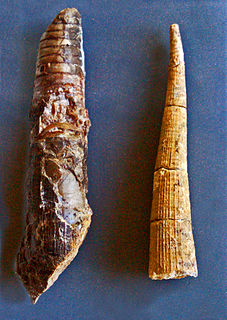Paraloxoceras is a genus of straight shelled, orthoconic nautiloid cephalopods, now extinct, that lived during the Early Carboniferous. Fossils have been found in Europe and central Asia; the type, P. konincki, named by Flower, came from Belgium.
Tetragonoceras is an extinct prehistoric nautiloid genus from the nautilid family Tetragonoceratidae that lived during the Middle Devonian, found in Canada.
Permoceras, the sole member of the family Permoceratidae, is a genus of coiled nautiloids with a smooth, compressed involute shell, whorls higher than wide, earlier whorls hidden from view. The venter is rounded as are the ventral and umbilical shoulders, the flanks flattened. The siphuncle is ventrally subcentral. The suture, which is most characteristic, has a deep, narrow pointed ventral lobe and large, asymmetrical pointed lobes on either side.
Jovellania is a genus of extinct prehistoric nautiloids from the order Oncocerida known from the Lower Devonian of Europe. Nautiloids form a broad group of shelled cephalopods that were once diverse and numerous but are now represented by only a handful of species in two genera.

Kionoceras is an extinct nautiloid cephalopod genus included in the orthocerid family Kionoceratidae with scattered worldwide distribution from the Middle Ordovician to the Lower Permian. Kionoceratids are orthocerids with prominent longitudinal ornamentation on their shells, sometimes augmented by secondary transverse ornamenttion. Orthocerids are, of course, prehistoric nautiloides with generally straight and elongate shells, mostly with central or subcentral siphuncles.
Endolobus is an extinct genus from the nautiloid order, Nautilida. Nautiloids are a subclass of shelled cephalopods that were once diverse and numerous but are now represented by only a handful of species, including Nautilus. Endolubus is included in the family Koninckioceratidae which is part of the superfamily Taintocerataceae.
Brevicoceras is an extinct nautiloid genus from the order Oncocerida with wide distribution in the Middle Devonian in Eastern North America, Russia and Morocco. Nautiloids form a broad group of shelled cephalopods that were once diverse and numerous but are now represented by only a handful of species in two genera.
Permonautilus is an extinct genus of nautilids from the Upper Permian of Russia, named and described by Kruglov in 1933. Permonautilus is an involute, globular, spinose member of the Lirocertidae which are included in the Clydonautilaceae. Whorl sections are broad, with a rounded venter. The umbilicus in the middle of the shell is deep, from which spine-like processes extend laterally in the mature portion near the aperture. The siphuncle in Permonautilus is subcentral, the suture, slightly sinuous.
Neocycloceras is an extinct genus of nautiloid included in the Pseudorthocerida that lived during the Late Devonian and Mississippian. Neoclycloceras is characterized by a slender, generally circular shell with slightly oblique,sinuous surficial annulations. Its sutures have dorsal and ventral saddles and lateral lobes and become more oblique with age. Saddles point forward, lobes to the rear. Dorsal saddles are broad and low but the ventral ones are high and conspicuous. The siphuncle is located between the center and venter and is nummuloidal, composed of rounded expanded segments, the inside of which contains a continuous laminar lining that is thickest in the middle of the segments and thinnest at the septal necks. Neocycloceras has been found in Pennsylvania in North America and in Morocco in north Africa.
Winnipegoceras is an extinct nautiloid genus from the Ordovician belonging to the Order Discosorida.
Zittelloceras is an extinct genus of nauiloids from the order Oncocerida which are among a large group of once diverse and numerous shelled cephalopods, now represented by only a handful of species.
Tetrapleuroceras is an extinct prehistoric nautiloid from the Lower Permian of the Urals in Russia. Nautilids are a type of nautiloid, a subclass of shelled cephalopods that were once diverse and numerous but now only represented by Nautilus and Allonautilus
Tithonoceras is a genus of nautiloid cephalopod from the Upper Jurassic found in the Crimea, belonging to the nautilacean family Paracenoceratidae.
Valhallites is an extinct genus in the nautiloid order Nautilida which includes the living Nautilus found in the tropical western Pacifiic. Valhalites belongs to the Koninckioceratidae, a family in the Tainoceratacea, a nautilid superfamily.
Tylonautilus is an extinct genus in the nautiloid order Nautilida from the Lower Carboniferous of Europe and Permian of Japan.
Heminautilus is an extinct genus of nautiloids from the nautilacean family Cenoceratidae that lived during the Early Cretaceous. Fossils of Heminautilus have been registered in rocks of Aptian age. Nautiloids are a subclass of shelled cephalopods that were once diverse and numerous but are now represented by only a handful of species.
Triboloceras is the name given to an extinct nautiloid genus from the Lower Carboniferous (Mississippian), included in the nautilid family Trigonoceratidae characterized by an evolute shell bearing longitudinal ribs, with whorls in contact except in the early and very latest growth stages. Chambers are short, sutures tend for form ventral and in some cases dorsal and lateral lobes. The siphuncle is small, tubular, and subcentral.

The Trigonoceratoidea are a superfamily within the Nautilida that ranged from the Devonian to the Triassic, thought to have contained the source for the Nautilaceae in which Nautilus is found.
The Tripteroceratidae is a family of depressed, straight to slightly curved nautiloid cephalopods from the middle and upper Ordovician with generally flattened venters and empty siphuncles with straight to inflated sedments included in the Oncocerida.



